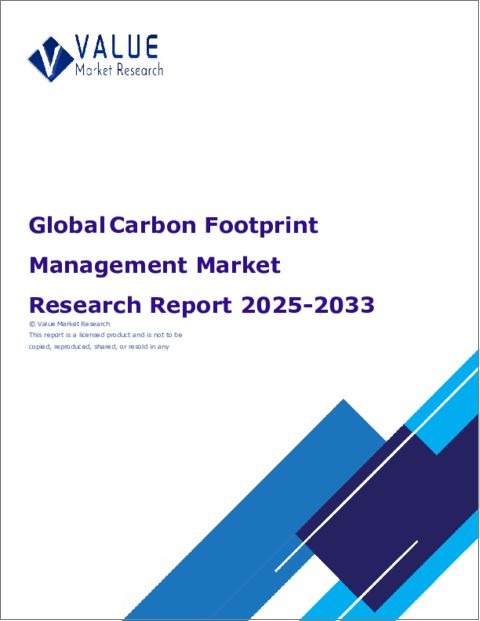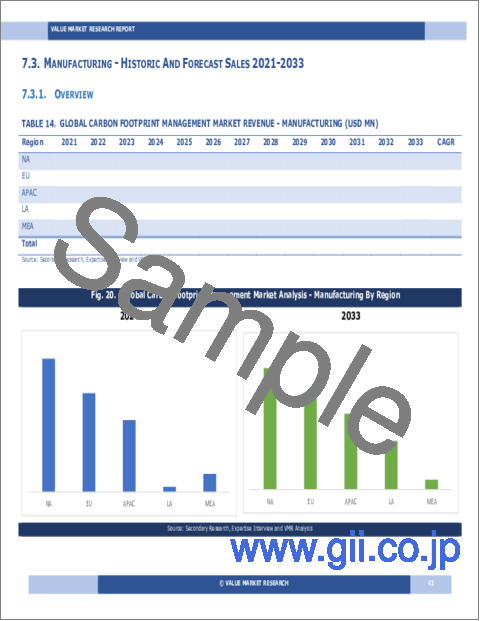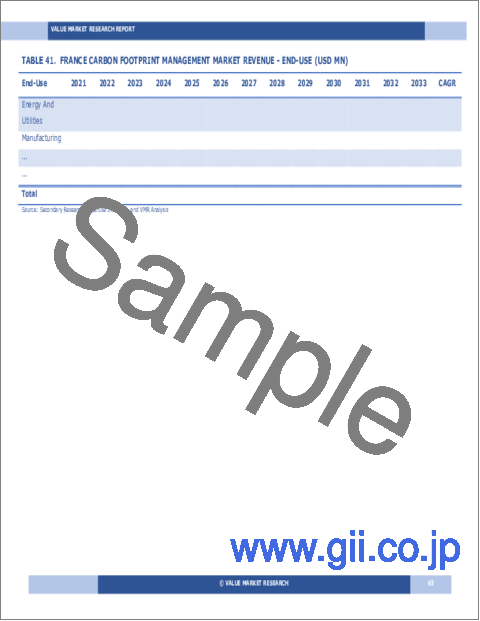|
|
市場調査レポート
商品コード
1721356
カーボンフットプリント管理の世界市場調査レポート:産業分析、規模、シェア、成長、動向、予測、2025年~2033年Global Carbon Footprint Management Market Research Report- Industry Analysis, Size, Share, Growth, Trends and Forecast 2025 to 2033 |
||||||
カスタマイズ可能
|
|||||||
| カーボンフットプリント管理の世界市場調査レポート:産業分析、規模、シェア、成長、動向、予測、2025年~2033年 |
|
出版日: 2025年04月01日
発行: Value Market Research
ページ情報: 英文 128 Pages
納期: 即日から翌営業日
|
全表示
- 概要
- 図表
- 目次
カーボンフットプリント管理の世界市場規模は、2024年の164億9,000万米ドルから2033年には370億8,000万米ドルに成長し、2026年から2033年の予測期間中に9.42%のCAGR(年間平均成長率)を記録すると予測されます。
企業が持続可能性と環境への責任をますます優先するようになり、カーボンフットプリント管理市場は大幅な成長を遂げようとしています。気候変動に対する意識の高まりと規制による圧力により、企業は二酸化炭素排出量を測定、管理、削減するための効果的なソリューションを求めています。カーボンフットプリント管理ツールは、企業が排出量を追跡し、削減の機会を特定し、持続可能性への取り組みについて報告することを可能にします。環境慣行における透明性と説明責任への要求が高まるにつれ、カーボンフットプリント管理ソリューションの市場は大幅に拡大すると予想されます。
さらに、技術の進歩がカーボンフットプリント管理ソリューションの機能を強化しています。データ分析、人工知能、IoTの統合により、企業は排出量に関するリアルタイムのデータを収集し、持続可能性への取り組みの影響を評価することができます。この技術的進化は、炭素会計の精度を向上させるだけでなく、組織が持続可能性の目標に沿ったデータ主導の意思決定を行うことを可能にします。企業の社会的責任を強化する上でカーボンフットプリント管理の価値を認識する企業が増えていることから、同市場は力強い成長を遂げる可能性が高いです。
さらに、規制遵守と持続可能性報告への注目の高まりが、カーボンフットプリント管理市場の将来を形成しています。政府や規制機関は、排出量報告に関するより厳しいガイドラインを導入しており、効果的な炭素管理ソリューションの導入が必要となっています。コンプライアンス要件が進化するにつれて、法的基準の遵守を促進するカーボンフットプリント管理ツールの需要が高まると予想されます。このような持続可能性とコンプライアンスへの注目は、カーボンフットプリント管理市場の革新と成長を引き続き促進し、現代のビジネス戦略における重要な要素として位置づけられるでしょう。
当社のレポートは、様々な産業や市場に関する包括的かつ実用的な洞察をお客様に提供するために綿密に作成されています。各レポートには、市場情勢を完全に理解するためのいくつかの重要な要素が含まれています:
市場概要:定義、分類、業界の現状など、市場に関する詳細なイントロダクション。
市場促進要因:市場成長に影響を与える主な促進要因・抑制要因・市場促進要因・課題を詳細に分析します。このセクションでは、技術の進歩、規制の変更、新たな動向などの要因を検証します。
セグメンテーション分析:製品タイプ、用途、エンドユーザー、地域などの基準に基づき、市場を明確なセグメントに内訳。この分析により、各セグメントの業績と将来性を明らかにします。
競合情勢:市場シェア、製品ポートフォリオ、戦略的イニシアティブ、財務実績など、主要市場プレイヤーの包括的評価。主要企業が採用する競合力学と主要戦略に関する考察を提供します。
市場予測:過去のデータと現在の市場状況に基づき、一定期間における市場規模と成長動向を予測します。これには、定量的分析と将来の市場軌跡を示すグラフ表示が含まれます。
地域分析:地域ごとの市場パフォーマンスを評価し、主要市場や地域動向を明らかにします。地域の市場力学とビジネスチャンスを理解するのに役立ちます。
新たな動向と機会:現在の市場動向と新たな市場動向、技術革新、潜在的な投資対象分野を特定します。将来の市場開拓と成長見通しに関する洞察を提供します。
目次
第1章 序文
第2章 エグゼクティブサマリー
- 市場のハイライト
- 世界市場スナップショット
第3章 カーボンフットプリント管理産業分析
- イントロダクション:市場力学
- 市場促進要因
- 市場抑制要因
- 機会
- 業界動向
- ファイブフォース分析
- 市場の魅力分析
第4章 バリューチェーン分析
- バリューチェーン分析
- 原材料分析
- 原材料リスト
- 原材料メーカーリスト
- 主要原材料の価格動向
- 潜在的バイヤーリスト
- マーケティングチャネル
- ダイレクトマーケティング
- インダイレクトマーケティング
- マーケティングチャネル発展動向
第5章 カーボンフットプリント管理の世界市場分析:展開別
- 概要:展開別
- 実績・予測データ分析:展開別
- オンプレミス
- クラウド
第6章 カーボンフットプリント管理の世界市場分析:タイプ別
- 概要:タイプ別
- 実績・予測データ分析:タイプ別
- ベーシック層
- ミッド層
- エンタープライズ層
第7章 カーボンフットプリント管理の世界市場分析:最終用途別
- 概要:最終用途別
- 実績・予測データ分析:最終用途別
- エネルギー・ユーティリティ
- 製造
- 輸送
- IT・通信
- 住宅・商業ビル
第8章 カーボンフットプリント管理の世界市場分析:地域別
- 地域別展望
- イントロダクション
- 北米の売上分析
- 概要、実績と予測
- 北米:セグメント別
- 北米:国別
- 米国
- カナダ
- メキシコ
- 欧州の売上分析
- 概要、実績と予測
- 欧州:セグメント別
- 欧州:国別
- 英国
- フランス
- ドイツ
- イタリア
- ロシア
- その他欧州
- アジア太平洋地域の売上分析
- 概要、実績と予測
- アジア太平洋地域:セグメント別
- アジア太平洋地域:国別
- 中国
- インド
- 日本
- 韓国
- オーストラリア
- 東南アジア
- その他アジア太平洋地域
- ラテンアメリカの売上分析
- 概要、実績と予測
- ラテンアメリカ:セグメント別
- ラテンアメリカ:国別
- ブラジル
- アルゼンチン
- ペルー
- チリ
- その他ラテンアメリカ
- 中東・アフリカの売上分析
- 概要、実績と予測
- 中東・アフリカ:セグメント別
- 中東・アフリカ:国別
- サウジアラビア
- アラブ首長国連邦
- イスラエル
- 南アフリカ
- その他中東・アフリカ
第9章 カーボンフットプリント管理企業の競合情勢
- カーボンフットプリント管理市場の競合
- 提携/協力/合意
- 合併・買収
- 新製品の発売
- その他の開発
第10章 企業プロファイル
- 上位企業の市場シェア分析
- 市場集中度
- Wolters Kluwer
- IBM Corporation
- Schneider Electric
- Dakota Software
- ENGIE
- IsoMetrix
- ProcessMAP
- Schneider Electric
- SAP
- Ecova
LIST OF TABLES
- Market Snapshot
- Drivers: Impact Analysis
- Restraints: Impact Analysis
- List of Raw Material
- List of Raw Material Manufactures
- Analysis By Deployment (USD MN)
- On Premise Market Sales By Geography (USD MN)
- Cloud Market Sales By Geography (USD MN)
- Analysis By Type (USD MN)
- Basic Tier Market Sales By Geography (USD MN)
- Mid-Tier Market Sales By Geography (USD MN)
- Enterprise Tier Market Sales By Geography (USD MN)
- Analysis By End-Use (USD MN)
- Energy and Utilities Market Sales By Geography (USD MN)
- Manufacturing Market Sales By Geography (USD MN)
- Transportation Market Sales By Geography (USD MN)
- IT and Telecommunication Market Sales By Geography (USD MN)
- Residential and Commercial Buildings Market Sales By Geography (USD MN)
- Global Carbon Footprint Management Market Sales By Geography (USD MN)
- North America Market Analysis (USD MN)
- United States Market Analysis (USD MN)
- Canada Market Analysis (USD MN)
- Mexico Market Analysis (USD MN)
- Europe Market Analysis (USD MN)
- Europe Market Estimate By Country (USD MN)
- United Kingdom Market Analysis (USD MN)
- France Market Analysis (USD MN)
- Germany Market Analysis (USD MN)
- Italy Market Analysis (USD MN)
- Russia Market Analysis (USD MN)
- Spain Market Analysis (USD MN)
- Rest of Europe Market Analysis (USD MN)
- Asia Pacific Market Analysis (USD MN)
- China Market Analysis (USD MN)
- Japan Market Analysis (USD MN)
- India Market Analysis (USD MN)
- South Korea Market Analysis (USD MN)
- Australia Market Analysis (USD MN)
- South East Asia Market Analysis (USD MN)
- Rest of Asia Pacific Market Analysis (USD MN)
- Latin America Market Analysis (USD MN)
- Brazil Market Analysis (USD MN)
- Argentina Market Analysis (USD MN)
- Peru Market Analysis (USD MN)
- Chile Market Analysis (USD MN)
- Rest of Latin America Market Analysis (USD MN)
- Middle East & Africa Market Analysis (USD MN)
- Saudi Arabia Market Analysis (USD MN)
- UAE Market Analysis (USD MN)
- Israel Market Analysis (USD MN)
- South Africa Market Analysis (USD MN)
- Rest of Middle East and Africa Market Analysis (USD MN)
- Partnership/Collaboration/Agreement
- Mergers And Acquisition
LIST OF FIGURES
- Research Scope of Carbon Footprint Management Report
- Market Research Process
- Market Research Methodology
- Global Carbon Footprint Management Market Size, By Region (USD MN)
- Porters Five Forces Analysis
- Market Attractiveness Analysis By Deployment
- Market Attractiveness Analysis By Type
- Market Attractiveness Analysis By End-Use
- Market Attractiveness Analysis By Region
- Value Chain Analysis
- Global Market Analysis By Deployment (USD MN)
- On Premise Market Sales By Geography (USD MN)
- Cloud Market Sales By Geography (USD MN)
- Global Market Analysis By Type (USD MN)
- Basic Tier Market Sales By Geography (USD MN)
- Mid-Tier Market Sales By Geography (USD MN)
- Enterprise Tier Market Sales By Geography (USD MN)
- Global Market Analysis By End-Use (USD MN)
- Energy and Utilities Market Sales By Geography (USD MN)
- Manufacturing Market Sales By Geography (USD MN)
- Transportation Market Sales By Geography (USD MN)
- IT and Telecommunication Market Sales By Geography (USD MN)
- Residential and Commercial Buildings Market Sales By Geography (USD MN)
- Global Market Sales (USD MN)
- North America Market Sales (USD MN)
- Europe Market Sales (USD MN)
- Asia Pacific Market Sales (USD MN)
- Latin America Market Sales (USD MN)
- Middle East & Africa Market Sales (USD MN)
- Recent Development in Industry
- Top Company Market Share Analysis
Kindly note that the above listed are the basic tables and figures of the report and are not limited to the TOC.
Global Carbon Footprint Management Market size is anticipated to grow from USD 16.49 Billion in 2024 to USD 37.08 Billion by 2033, showcasing a robust Compound Annual Growth Rate (CAGR) of 9.42% during the forecast period of 2026 to 2033.
The carbon footprint management market is poised for substantial growth as organizations increasingly prioritize sustainability and environmental responsibility. With growing awareness of climate change and regulatory pressures, businesses are seeking effective solutions to measure, manage, and reduce their carbon emissions. Carbon footprint management tools enable organizations to track their emissions, identify reduction opportunities, and report on their sustainability efforts. As the demand for transparency and accountability in environmental practices rises, the market for carbon footprint management solutions is expected to expand significantly.
Moreover, advancements in technology are enhancing the capabilities of carbon footprint management solutions. The integration of data analytics, artificial intelligence, and IoT allows organizations to gather real-time data on their emissions and assess the impact of their sustainability initiatives. This technological evolution not only improves the accuracy of carbon accounting but also enables organizations to make data-driven decisions that align with their sustainability goals. As businesses increasingly recognize the value of carbon footprint management in enhancing their corporate social responsibility, the market is likely to witness robust growth.
Additionally, the increasing focus on regulatory compliance and sustainability reporting is shaping the future of the carbon footprint management market. Governments and regulatory bodies are implementing stricter guidelines for emissions reporting, necessitating the adoption of effective carbon management solutions. As compliance requirements evolve, the demand for carbon footprint management tools that facilitate adherence to legal standards is expected to rise. This focus on sustainability and compliance will continue to drive innovation and growth in the carbon footprint management market, positioning it as a critical component of modern business strategies.
Our reports are meticulously crafted to provide clients with comprehensive and actionable insights into various industries and markets. Each report encompasses several critical components to ensure a thorough understanding of the market landscape:
Market Overview: A detailed introduction to the market, including definitions, classifications, and an overview of the industry's current state.
Market Dynamics: In-depth analysis of key drivers, restraints, opportunities, and challenges influencing market growth. This section examines factors such as technological advancements, regulatory changes, and emerging trends.
Segmentation Analysis: Breakdown of the market into distinct segments based on criteria like product type, application, end-user, and geography. This analysis highlights the performance and potential of each segment.
Competitive Landscape: Comprehensive assessment of major market players, including their market share, product portfolio, strategic initiatives, and financial performance. This section provides insights into the competitive dynamics and key strategies adopted by leading companies.
Market Forecast: Projections of market size and growth trends over a specified period, based on historical data and current market conditions. This includes quantitative analyses and graphical representations to illustrate future market trajectories.
Regional Analysis: Evaluation of market performance across different geographical regions, identifying key markets and regional trends. This helps in understanding regional market dynamics and opportunities.
Emerging Trends and Opportunities: Identification of current and emerging market trends, technological innovations, and potential areas for investment. This section offers insights into future market developments and growth prospects.
SEGMENTATION COVERED IN THE REPORT
By Deployment
- On Premise
- Cloud
By Type
- Basic Tier
- Mid-Tier
- Enterprise Tier
By End-Use
- Energy and Utilities
- Manufacturing
- Transportation
- IT and Telecommunication
- Residential and Commercial Buildings
- COMPANIES PROFILED
- Wolters Kluwer
- IBM Corporation
- Schneider Electric
- Dakota Software
- ENGIE
- IsoMetrix
- ProcessMAP
- Schneider Electric
- SAP
- Ecova.
- The above list can be customized.
TABLE OF CONTENTS
1. PREFACE
- 1.1. Report Description
- 1.1.1 Objective
- 1.1.2 Target Audience
- 1.1.3 Unique Selling Proposition (USP) & offerings
- 1.2. Research Scope
- 1.3. Research Methodology
- 1.3.1 Market Research Process
- 1.3.2 Market Research Methodology
2. EXECUTIVE SUMMARY
- 2.1. Highlights of Market
- 2.2. Global Market Snapshot
3. CARBON FOOTPRINT MANAGEMENT INDUSTRY ANALYSIS
- 3.1. Introduction - Market Dynamics
- 3.2. Market Drivers
- 3.3. Market Restraints
- 3.4. Opportunities
- 3.5. Industry Trends
- 3.6. Poerter's Five Force Analysis
- 3.7. Market Attractiveness Analysis
- 3.7.1 Market Attractiveness Analysis By Deployment
- 3.7.2 Market Attractiveness Analysis By Type
- 3.7.3 Market Attractiveness Analysis By End-Use
- 3.7.4 Market Attractiveness Analysis By Region
4. VALUE CHAIN ANALYSIS
- 4.1. Value Chain Analysis
- 4.2. Raw Material Analysis
- 4.2.1 List of Raw Materials
- 4.2.2 Raw Material Manufactures List
- 4.2.3 Price Trend of Key Raw Materials
- 4.3. List of Potential Buyers
- 4.4. Marketing Channel
- 4.4.1 Direct Marketing
- 4.4.2 Indirect Marketing
- 4.4.3 Marketing Channel Development Trend
5. GLOBAL CARBON FOOTPRINT MANAGEMENT MARKET ANALYSIS BY DEPLOYMENT
- 5.1. Overview By Deployment
- 5.2. Historical and Forecast Data Analysis By Deployment
- 5.3. On Premise Historic and Forecast Sales By Regions
- 5.4. Cloud Historic and Forecast Sales By Regions
6. GLOBAL CARBON FOOTPRINT MANAGEMENT MARKET ANALYSIS BY TYPE
- 6.1. Overview By Type
- 6.2. Historical and Forecast Data Analysis By Type
- 6.3. Basic Tier Historic and Forecast Sales By Regions
- 6.4. Mid-Tier Historic and Forecast Sales By Regions
- 6.5. Enterprise Tier Historic and Forecast Sales By Regions
7. GLOBAL CARBON FOOTPRINT MANAGEMENT MARKET ANALYSIS BY END-USE
- 7.1. Overview By End-Use
- 7.2. Historical and Forecast Data Analysis By End-Use
- 7.3. Energy and Utilities Historic and Forecast Sales By Regions
- 7.4. Manufacturing Historic and Forecast Sales By Regions
- 7.5. Transportation Historic and Forecast Sales By Regions
- 7.6. IT and Telecommunication Historic and Forecast Sales By Regions
- 7.7. Residential and Commercial Buildings Historic and Forecast Sales By Regions
8. GLOBAL CARBON FOOTPRINT MANAGEMENT MARKET ANALYSIS BY GEOGRAPHY
- 8.1. Regional Outlook
- 8.2. Introduction
- 8.3. North America Sales Analysis
- 8.3.1 Overview, Historic and Forecast Data Sales Analysis
- 8.3.2 North America By Segment Sales Analysis
- 8.3.3 North America By Country Sales Analysis
- 8.3.4 United States Sales Analysis
- 8.3.5 Canada Sales Analysis
- 8.3.6 Mexico Sales Analysis
- 8.4. Europe Sales Analysis
- 8.4.1 Overview, Historic and Forecast Data Sales Analysis
- 8.4.2 Europe By Segment Sales Analysis
- 8.4.3 Europe By Country Sales Analysis
- 8.4.4 United Kingdom Sales Analysis
- 8.4.5 France Sales Analysis
- 8.4.6 Germany Sales Analysis
- 8.4.7 Italy Sales Analysis
- 8.4.8 Russia Sales Analysis
- 8.4.9 Rest Of Europe Sales Analysis
- 8.5. Asia Pacific Sales Analysis
- 8.5.1 Overview, Historic and Forecast Data Sales Analysis
- 8.5.2 Asia Pacific By Segment Sales Analysis
- 8.5.3 Asia Pacific By Country Sales Analysis
- 8.5.4 China Sales Analysis
- 8.5.5 India Sales Analysis
- 8.5.6 Japan Sales Analysis
- 8.5.7 South Korea Sales Analysis
- 8.5.8 Australia Sales Analysis
- 8.5.9 South East Asia Sales Analysis
- 8.5.10 Rest Of Asia Pacific Sales Analysis
- 8.6. Latin America Sales Analysis
- 8.6.1 Overview, Historic and Forecast Data Sales Analysis
- 8.6.2 Latin America By Segment Sales Analysis
- 8.6.3 Latin America By Country Sales Analysis
- 8.6.4 Brazil Sales Analysis
- 8.6.5 Argentina Sales Analysis
- 8.6.6 Peru Sales Analysis
- 8.6.7 Chile Sales Analysis
- 8.6.8 Rest of Latin America Sales Analysis
- 8.7. Middle East & Africa Sales Analysis
- 8.7.1 Overview, Historic and Forecast Data Sales Analysis
- 8.7.2 Middle East & Africa By Segment Sales Analysis
- 8.7.3 Middle East & Africa By Country Sales Analysis
- 8.7.4 Saudi Arabia Sales Analysis
- 8.7.5 UAE Sales Analysis
- 8.7.6 Israel Sales Analysis
- 8.7.7 South Africa Sales Analysis
- 8.7.8 Rest Of Middle East And Africa Sales Analysis
9. COMPETITIVE LANDSCAPE OF THE CARBON FOOTPRINT MANAGEMENT COMPANIES
- 9.1. Carbon Footprint Management Market Competition
- 9.2. Partnership/Collaboration/Agreement
- 9.3. Merger And Acquisitions
- 9.4. New Product Launch
- 9.5. Other Developments
10. COMPANY PROFILES OF CARBON FOOTPRINT MANAGEMENT INDUSTRY
- 10.1. Top Companies Market Share Analysis
- 10.2. Market Concentration Rate
- 10.3. Wolters Kluwer
- 10.3.1 Company Overview
- 10.3.2 Company Revenue
- 10.3.3 Products
- 10.3.4 Recent Developments
- 10.4. IBM Corporation
- 10.4.1 Company Overview
- 10.4.2 Company Revenue
- 10.4.3 Products
- 10.4.4 Recent Developments
- 10.5. Schneider Electric
- 10.5.1 Company Overview
- 10.5.2 Company Revenue
- 10.5.3 Products
- 10.5.4 Recent Developments
- 10.6. Dakota Software
- 10.6.1 Company Overview
- 10.6.2 Company Revenue
- 10.6.3 Products
- 10.6.4 Recent Developments
- 10.7. ENGIE
- 10.7.1 Company Overview
- 10.7.2 Company Revenue
- 10.7.3 Products
- 10.7.4 Recent Developments
- 10.8. IsoMetrix
- 10.8.1 Company Overview
- 10.8.2 Company Revenue
- 10.8.3 Products
- 10.8.4 Recent Developments
- 10.9. ProcessMAP
- 10.9.1 Company Overview
- 10.9.2 Company Revenue
- 10.9.3 Products
- 10.9.4 Recent Developments
- 10.10. Schneider Electric
- 10.10.1 Company Overview
- 10.10.2 Company Revenue
- 10.10.3 Products
- 10.10.4 Recent Developments
- 10.11. SAP
- 10.11.1 Company Overview
- 10.11.2 Company Revenue
- 10.11.3 Products
- 10.11.4 Recent Developments
- 10.12. Ecova
- 10.12.1 Company Overview
- 10.12.2 Company Revenue
- 10.12.3 Products
- 10.12.4 Recent Developments






